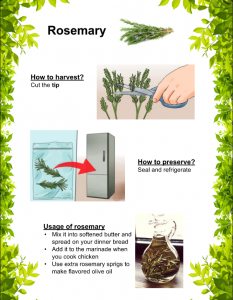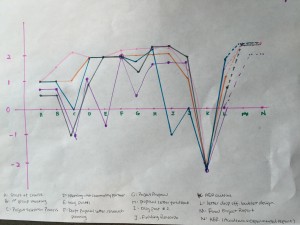Time flies! It’s almost the end of the project and we are looking forward to building new herb gardens with Gordon Neighborhood House. These gardens will start producing herbs for the neighborhood in the summer of 2016 and will continue to provide delicious herbs until the fall. They will make an impact in the community by spreading awareness of sustainable farming and improve food literacy!
In this blog post we will be sharing our weekly objectives & achievements, a moment of significant change, and strategies for successful project completion.
Weekly Objectives and Achievements
Week 7 Feb 15th – Feb 19th (Reading Break):
Over the reading break, we researched about 20+ types of herbs that are suitable to grow under the weather conditions in Vancouver. We also researched about harvest methods, culinary use, and sample meals for each herb. These herbs include, but not limited to: purple basil, bay leaves, chervil, dill, fennel, cilantro, and lemon balm.
Week 8 Feb 22nd – Feb 26th :
We continue our booklet design that the community partner has requested. Below is the potential herb booklet that is going to be placed near herb gardens for everyone to view.

Week 9 Feb 29th – Mar 4th :
Our community partner got back to us with the signed proposal letter that was to be delivered to property managers at the 15 preferred locations mentioned previously in blog 2.
Week 10 Mar 7th – 11th:
This week we have completed delivering letters to the potential sites. Our community member mentioned that one property manager has responded and was very positive about the herb gardens. As of now, we have in total two locations to build the beds.
Group’s Moment of Significant Change

We all started out fairly optimistic for our first group meeting. Then, we were all disappointed after the project selection process as we were not assigned to one of the top three projects we expected. This was where our anxiety started to build up as we lacked confidence in the other projects. However, our morale changed when we met our community partner for the first time. She was very clear and specific about our project and what the organization expected. We delegated tasks to two major groups: marketing & designing and site hunting group.
We all had the positive moment when our project proposal received great feedback. In addition to this, our community partner was satisfied with the way we presented the proposal letter for potential property managers.
Currently we are concerned about the collecting data; whether we should use quantitative, qualitative, or mixed-method approaches. Our project in nature does not have any quantitative data since the our major goal is to expand herb gardens. We have thought about interviewing residents on their thoughts about free herb gardens on Boulevards and how many people have actually used the herb gardens. However, we would not be able to do so since these types of data collection can only be done in the summer; by then we would have already had finished the course. We are also concerned about what materials we are going to use for the logo in order to increase its visibility and attractiveness to passersby. Since we have a few more sessions left to work with GNH, we will work with them to finalize our project and possibly tend to their further requests. Although we have ups and downs during the progress of this project, we have the same goal as to finish this project perfectly.
Strategies for Successful Project Completion
‧We determined that we would conduct a qualitative method approach by creating a criteria sheet for our community partner to evaluate our overall quality of research, herb booklets, and logo design.
‧Good visible wood sign: Nail the laminated sign onto the wood and change as it wears out. The wood sign will be stuck into soil and will not take up spaces.

(Image from: http://depositphotos.com/38473051/stock-photo-wooden-road-sign-board-old.html)
Although currently we are slightly concerned and uncertain about how the project will end successfully, we take this as a challenge to keep us going. We were concerned whether the letters would be delivered to the property owners successfully. We were also worried that the property owners would feel stressed that they have to get involved in the process of building the beds. Therefore, we included a map of current existing herb gardens in the letter and encouraged the owners to visit. We also welcomed his/her residential tenants to visit the herb gardens. This way, we tried not to be overly forceful in asking for use of their lands; instead, we intended to invite them to join this community activity. Our goal was to expand the herb gardens by converting the potential spaces in the cities. However, whether or not the property owners lend us their lands, with more people engaged in the herb gardens, the more widely the messages would be spread throughout the community. If we are free of concerns we may not learn as much. As our instructor mentioned in class, some uncertainty and a small level of anxiety keeps us thinking and learning during the process. This also reinforces flexible cognitive thinking. The statement coincides with Yerkes-Dodson Law; the law states tasks require certain levels of arousal (anxiety) in order to achieve optimal performance (Lupien et al, 2007). However the level of arousal varies upon tasks and personal experiences.
City development has taken away the forests and fertile lands; roughly 25% of farmland has been lost in the past 10 years (Mullinix et al, 2009). With time, city residents become increasingly unknowledgeable of their food sources. Gradually, the gap between food and human well-being is widened. Human well-being ties strongly to the economy, the social situation, and the environment. The herb garden expansion project may contribute to lessen the gap between people and the environment without requiring the use of more lands. Instead, the idea is to find potentially useable spaces in the cities. This can improve food literacy and access and directly mitigate climate change (Mullinix et al, 2009). On average, the age of a farmer in Canada is 55 years old. It is imperative that we encourage agriculture-related job opportunities to the younger generations in Vancouver (Mullinix et al, 2009).
Upcoming Weekly Objectives
For the upcoming weeks we will follow up with Gordon Neighborhood House and potentially start building raised beds at two potential sites as well as maintenance of the existing beds. We will also determine the slogan and modify the booklet if needed.
In short, by doing the “moment of significance” exercise, we were able to arrive at a common goal with GNH. We have also identified the areas that we needed to improve on. We hope to receive feedback from the community partner on the signage and overall progress before the project ends, so that we have time to improve.
The next blog will be our last blog before the semester ends! Please check back and see our final reflection on this term project. We will have a brief summary of the project and discuss how community gardens play a part in improving food literacy and food access.
References
Lupien, S. J., Maheu, F., Tu, M., Fiocco, A., Schramek, T. E., & Elsevier Scientific Publishing Co., New York, NY. (2007). The effects of stress and stress hormones on human cognition: Implications for the field of brain and cognition.Brain and Cognition, 65(3), 209-237. doi:10.1016/j.bandc.2007.02.007
Mullinix, Fallick, & Henderson, 2009. Beyond Food Security: Urban agriculture as a form of resilience in Vancouver, Canada.